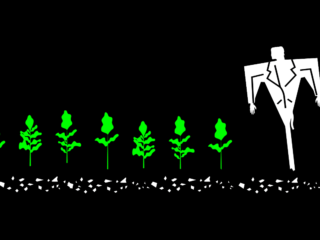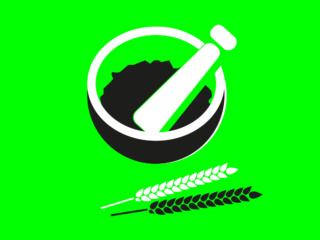WHAT’S the best veg for a beginner GARDENER TO GROW? A SQUASHY ONE

Starting to grow vegetables for the first time can be a disheartening experience. Seeds might not germinate; young plants can be massacred by pests; and those that do survive may either hardly crop, or not crop at all. Often problems like these are just down to inexperience, and given a couple of seasons you’ll overcome most of them. But some plants are just a whole lot trickier than others.
Cauliflower, for instance. This is a notoriously arsy customer, bolting at the slightest stress, and refusing to make those tight white flower heads (known as “curds’) unless you fuss over them like a bride-to-be. And yes, a whole roasted, spiced cauliflower is a lovely thing to eat, and a whole head provides roughly seven days’ worth of Vitamin C* – but if a beginner tries to grow them, they’re likely to lose the will to live before the first season is over.
Which is why, when an interviewer from Kitchen Garden magazine asked us the other day about what veg we’d recommend for the less green-fingered to grow, we got thinking about what counts as the Anti-Cauliflower. What, in others words, is simple to handle, germinate and plant out? What doesn’t require too much attention once it’s growing? And what will give you prideful, I-shall-survive-the-apocalypse feeling at harvest time?
The answer we settled on was squash. One kind of squash in particular: courgettes.
Swish squash
First of all, let’s clear up what a “squash” is, exactly. That can be confusing. Non-gardeners tend to think of squash as the bottle-shaped, creamy-yellow coloured veg that supermarkets call “butternut”. But other squash (eg Hokkaido, Green Kabocha) are large and round, like pumpkins – which are also, in fact, squash. Then Americans do this thing of talking about “winter squash” (Atlantic Giant pumpkins, Sweet Dumpling, Turks Turban, or any other kind you eat when the rinds are hard ) and “summer squash” (which you eat, yes, in summer, when the rinds are still soft). Complicated, much.
So although Latin might make your eyes swivel, it is actually easiest to nail down what a squash is by sticking to botanics. Because then all the squash in a zombie garden will be varieties of one of three species: Curcurbita maxima, Cucurbita moschita or Cucurbita pepo.
- The maximas originated as a wild plant in temperate South America, tend to grow long vines, and are the gang that produce most of the really big pumpkins, the kind that men (and yes it is usually men) enter into giant-veg competitions.
- Moschatas are also viney and spreading, but come from the hotter, wetter and more tropical parts of South America; despite that, cultivated varieties have been developed that grow fine in cooler, temperate places like the UK — including several very useful varieties of butternut squash.
- Last up are the pepos, which were originally native to temperate North America, and which include smaller, vining pumpkins, acorn-shaped squash, and, crucially, bushy courgettes and marrows.
“Any plant that grows big leaves, fast, is particularly rewarding when you start gardening – you feel you’re getting plenty of bang for your muck”
It’s the courgettey versions of C. pepo that we think are a fun and rewarding place to start, whether you’re growing in containers or in open ground. Courgette seeds are flat, oval and around 1 cm or so long, which makes them easy to handle at sowing time. Because they’re large seeds, you can sow and grow on in the same pot, saving the hassle of pricking out. Once germinated, they make two fat, sturdy baby leaves that are impossible for inexperienced gardeners to miss, arefollowed by large jagged and often slightly marbled adult leaves. And any plant that grows big leaves, fast, is particularly rewarding when you start gardening: you feel you’re getting plenty of bang for your muck.
In ideal conditions, courgettes are so speedy they can begin cropping just eight weeks after sowing, but 10-12 weeks is more usual. As long as there are bees about to pollinate the crumply yellow, trumpet-like flowers (which, incidentally, are delicious stuffed and fried), and you keep picking the young fruit, they will keep cropping until the end of the summer.
And boy, when they crop they really crop. Courgettes are the classic glut-vegetable: they need picking every two to three days at their peak, and zombie gardeners often find themselves running out of people to give /force spare courgettes on in August.
Not everyone finds them easy plants, though. We know at least one otherwise very skilled zombie gardener in Australia who struggles to get their courgette seed to germinate; if they do, they then can’t seem to to get the plants to grow on. Maybe they don’t like being upside down.
Whatever, we wanted to check whether a courgette expert would agree with us that they’re a good starter plant. So we spoke to Steve Whitworth of Oakley Farms in Cabridgeshire. Oakley are one of the largest courgette producers in the UK, sowing seed two times a year undercover in their enormous nursery space, then moving young plants out to grow on in hectares and hectares of flat fields, where they’re harvested by one of the largest fleets of courgettes rigs in the country. So they know what they’re doing. And while Steve reckoned he’d rather you bought your courgettes from him – at least until early autumn, when the British courgette season finishes and imports from southern Spain take over to fill the gap – he did agree that, if you have to grow your own, they’re a lovely, simple plant that yields well without taking up much space.
There are only really two rules
to growing courgettes, Steve
reckons: “Keep them warm, and
don’t over-water.”
There are only really two rules to growing courgettes, Steve reckons: “Keep them warm, and don’t over-water.” Cold weather slows their growth, and a frost will smash the plants to mush in a night, so for most of the UK that means sowing by mid-May, and getting young plants in the ground by the start of July; if you’re planting out early, consider tucking young plants under cloches or fleece for the first couple of weeks.
But they don’t need masses of heat. What they’re more interested in, Steve says, is the number of hours’ of daylight they can get. This is why plants sown closer to midsummer, the point where nights begin to be longer than days, won’t yield as well as those sown well before 21 June. And why is over-watering a problem? Because, Steve explains, they are by nature a deep-rooted plant, putting down a long tap root and absorbing water very efficiently: if there’s too much of it in the soil, they’ll keep on sucking it up until the fruits split and/or go spongy-soggy inside.
How to sow and grow
So, nitty-gritty time. This is how we’d recommend gardeners in the UK grow courgettes – but as always, we really like to hear and share others’ experiences, so please Tweet/Insta/email us your thoughts!
- Sow in 9cm-across-the-top pots or modules any time from mid-April to late May; but remember that later-sown plants won’t fruit so heavily.
- Sow the seeds 1 cm deep in a #peat-free seed compost, or your own 1:1 mix of top soil and leaf mould. Like all squash seeds, they’re prone to rotting before they can germinate, so stand them on edge so that water doesn’t sit on their flat surfaces.
- Cover pots with a sheet of glass, perspex, newspaper, or a plastic bag to keep humidity high.
- Germinate them fast, to avoid rotting: 18 degrees C is fine, but they usually pop up quicker at a steady 22 degrees, which means either using a heated propagator or keeping them indoors somewhere warm.
- Check every day for germination, which should take between four to 14 days.
- Once they’re up, grow them on somewhere warm and bright until the third jagged leaf appears, then harden them off. We tend to leave ours in the cold frame until they’ve got four to five adult leaves, as they seem to fight off slugs better at that size. Any longer than that, though, and the plants growth will be checked, and yields will suffer.
- Plant out one per square metre of soil/large container, from which you can expect an average of between 2-4 kg of fruit, depending on which cultivar you’re growing. (For anyone worried about scurvy, that would give you up to 16 days UK GDR of Vitamin C*. As well as a whole load of ratatouille.)
- Protect them from slugs with every weapon in your arsenal: beer traps are particularly useful at planting out time, though don’t forget to top them up after a heavy rainfall.
- Give them a liquid potassium feed (eg tomato fertiliser, comfrey tea) every two weeks until fruit starts to swell
- Once fruit are 10-15cm long, cut them away from the main stem with a sharp knife.
As for varieties, in open ground we tend to stick to open-pollinated All Green Bush (why open-pollinated? We’ll post about this another day), and would recommend compact Verde di Milano to grow in pots 45cm or are deep. Both are widely available, though we recommend the Real Seed Company for good quality, fresh seed that comes with a properly useful set of sowing instructions.

Bolting One of our grandmothers used to describe any woman who left her husband as “a bolter”. A plant that bolts isn’t, however, making a desperate bid for financial and sexual independence, it’s responding to some form of stress. Not, in this case, a lack of financial and sexual independence, but too much cold or heat, or too little water or nutrients. Any of which can make it flower and set seed, rather than concentrating on growing the roots, leaves or other bits that you want to eat.

* Based on USDA FoodData Central figures for one medium head cauliflower, and average UK GDR for one adult
* Based on average of yields for courgettes and marrows in Pollock, RHS Fruit and Vegetable Gardening and Beazley, RHS Allotment Gardening; and average UK GDR for one adult








